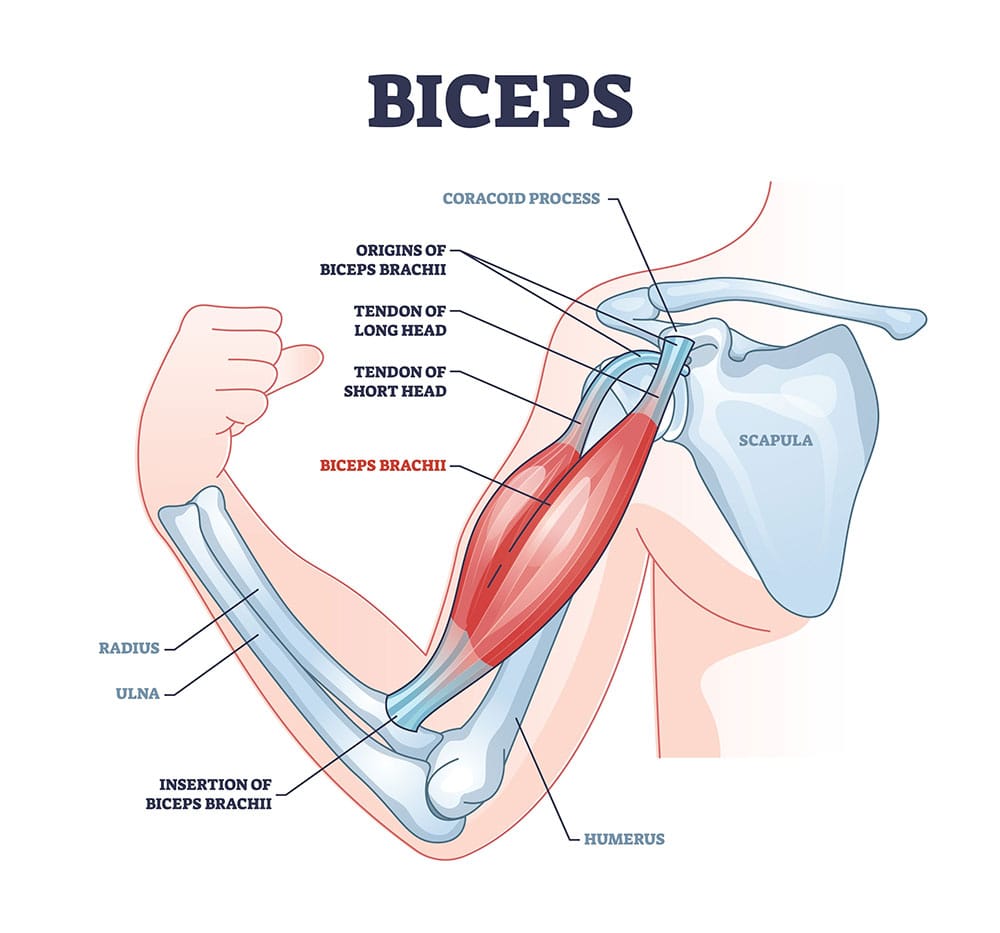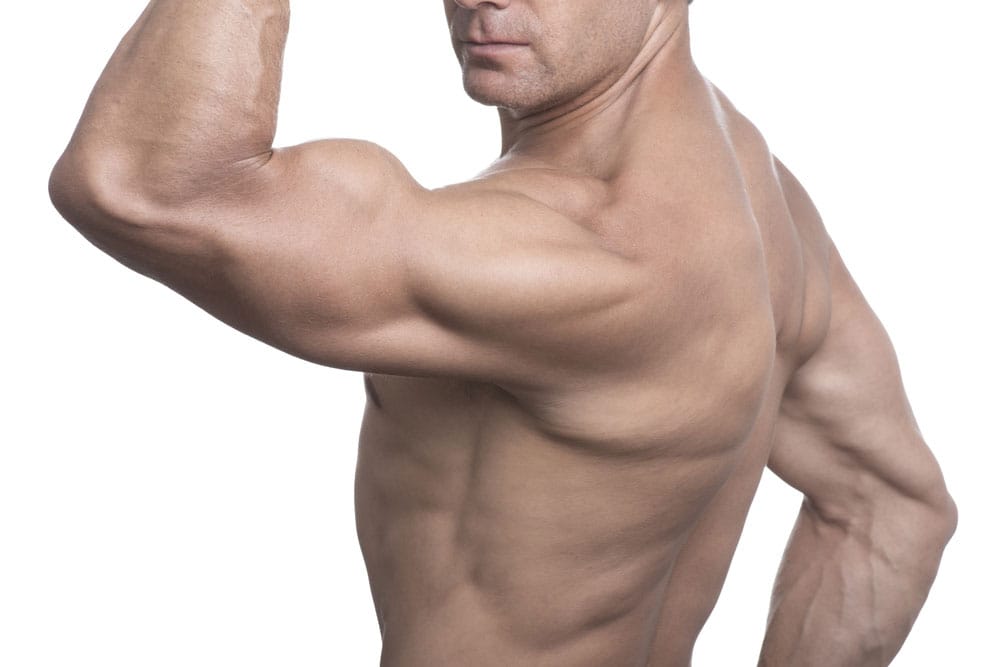How to Make Your Bicep Veins Show?
Understand the principles behind vascularity and learn how to get visible bicep veins.
We’ve all seen them: Those guys at the gym who seem to be made of veins.
The look makes every muscle pop perfectly. Even for slim guys, visible veins can enhance the look of any muscle you may have, making you look stronger than you really are.
Veiny abs or bulging bicep veins indicate low body fat with a lot of muscle. But what really makes your veins pop?
They tend to look good. And if you’re a guy, the veins drive women crazy. Not too shabby of a perk.
Today we’ll look at the coveted bicep vein. Do these things come from nature or nurture?
Can you train for the vein? We’ll unpack some training, diet, and lifestyle suggestions on how to get visible bicep veins.
Bicep anatomy

You probably don’t need much of an introduction to these muscles.
But in case you want to brush up or need a crash course, your biceps brachii, usually called just “biceps” are the upper arm muscles that bring your forearms toward your upper arms. These are double-headed muscles that work as key forearm flexors. They also help you supinate your forearm, which means to rotate outward.
It originates from two spots: the coracoid process of your scapula (shoulder blade) and the supraglenoid tubercle, also along the head of your scapula.
Both heads of the bicep insert at the radius: one of your two large forearm bones.
What is vascularity?
In the bodybuilding and weight training world, it’s common to hear that someone is super “vascular.” This means they’re veiny!
People with higher ratios of muscle to fat tend to be more vascular.
Why?
If we think about the respective structures of muscle and fat and how they sit and operate in the body, we can understand how they help your veins pop.
If you have higher body fat, it sits below the surface of your skin, covering your veins.
What are the types of veins?
Superficial veins
If you’re looking for bicep veins that POP for a little ooh la la when you lift, you’re in the realm of superficial veins.
Your shallower veins, called “superficial veins” sit at this level. If you have high fat, the fat can surround and obscure them. Less body fat increases the probability that people will see your veins since you won’t have much of a fat layer acting as a cover.
Deep veins
There are veins that sit within your muscles too, deeper underneath the surface of your skin, but muscles will often push the superficial veins out so you can see them. This is what happens when you have prominent bicep veins.
Why are some people veinier than others?
There are a few reasons why some people's bicep veins may be much easier to spot:
Genetics
Your veins naturally sit a certain way just based on your genetics and body composition.
Have you ever gone to get blood drawn and had to be pinpricked multiple times since the nurse couldn’t find a vein?
It’s possible that you have naturally deeper set veins. On the other hand, if they exclaimed “Wow, you bleed well!” your veins are probably much more shallow.
It’s not necessarily good or bad to have deeper or shallower veins, although it may make drawing blood a challenge.
The size of your veins is a bit more important. Veins that are smaller in diameter hold less blood. In this case, blood needs to be passed off to your arteries which can overload them and increase your blood pressure.
Some people, too, have bad bicep genetics, where the muscles themselves are not well-developed. If your biceps are naturally on the smaller side or don’t have optimal peaks or insertion points, you may not notice or be able to show off your veins.

Skin Color
If you have very fair skin, it can look translucent and frequently show blue veins. People with darker skin may have
Age
We experience chronic skin fragility from aging. As we get older, our skin tends to thin out. This can make veins more visible under the skin in older people.
Gender
Men generally have more visible veins than women. This is due to a few factors.
Generally, men have less body fat than women, leading their veins to be more visible. Furthermore, when training for aesthetics, many men WANT their veins to show, while women tend to be less interested in this staple as part of an attractive physique.
Female athletes are often more concerned about learning how to get a round butt or how to get wider hips vs. getting bicep veins. It’s not as much of a popular priority for most women, which is why we don’t tend to notice female bicep veins as much.
Training Experience
People who train hard tend to have veiny arms due to more muscle mass. When you resistance train, you increase your body’s stores of lean muscle.
How do I get my bicep veins to show?
Decrease body fat
Reducing excess fat that covers your bicep veins will let them show through.
How can you get rid of arm fat?
It’s impossible to spot reduce (a myth that continues to persist!). Instead, you’ll need to lower your body fat as a whole.
Focus on exercising at least 2-3 times a week if you’re a total beginner. Most people need more than this. The Center for Disease Control and Prevention guidelines recommend at least 150 minutes of moderate-intensity exercise per week.
In this measure, you should get at least 2 days of strength training.
Diet is just as important, if not more to fat loss. Eating at a calorie deficit can help you lose body fat.
Focus on nutrient density in your meals and make sure you’re getting the recommended amount of carbohydrates, protein, and healthy fats. Typically, the recommendation for these essential macronutrients is:
- 45-65% carbohydrates
- 20-35% fat
- 10-35% protein
Within this ballpark, your numbers can vary quite a bit and still be healthy. For example, a marathon runner would have a different best ratio than a powerlifter.
Both of these people, too, would have different recommended compositions than someone who is overweight, takes light walks daily and is looking to shed a few pounds.
If you have no clue where to start on balancing your macronutrient ratios, a dietitian or nutritionist can help you create a plan that suits your lifestyle and fitness goals and your grocery budget.
Build lean muscle

Building lean muscle and getting your muscles to swell and grow can help to push the veins closer to the surface of your skin.
This creates a more vascular look. If you want pumped-up and healthy-looking biceps, strength training at least 2-3 times a week is a good bet for beginners.
To increase your results, you may want to look at alternative training splits. If you follow a bro split workout plan, for example, you get a whole day devoted just to training your arms.
If you have stubborn arm muscles or deep-set veins, fine-tuning your bicep training program can be the way that you finally break through and begin to see more bicep veins.
Work on exercises that target your biceps and their surrounding muscles. You’ll want to do moves like bicep curls and other bicep peak exercises.
But you should hit your triceps and forearms too. Surrounding muscles like your brachialis and brachioradialis can all have a hand in how strong your biceps look and how well they perform.
You can get more targeted workouts for these muscles here:
- Medial Head Tricep Exercises
- Short Head Tricep Exercises
- Do Hand Grippers Work?
Reduce water retention

Isn’t water retention good?
We’re always hearing the message to hydrate, hydrate, hydrate.
But water retention in certain parts of the body, also called edema, can lead to excessive swelling. If you’ve ever felt bloated or seen an increase in your weight quickly and with seemingly no reason, you could be dealing with “water weight” or water retention.
More than half of your body is made up of water. But when your hydration levels aren’t properly balanced, you may retain the water in ways that aren’t optimal, rather than processing it.
Edema can also be a symptom of serious health conditions like kidney disease or heart failure.
More often than not, it’s caused by something in your lifestyle or diet that may be throwing your water balance off. For instance:
- Flying in an airplane (cabin pressure changes)
- Sitting for too long
- Consuming too much sodium
- Pregnancy
- Some medications
- Menstrual cycle
- Kidney disease or liver cirrhosis
Water retention can cause you to look bloated overall. This can hide vascularity in even the best-trained people. If you think you’re retaining water in a way that negatively affects your health or appearance:
- Reduce your salt intake
- Eat potassium-rich foods like bananas
- Make sure you’re consuming enough protein
- Try wearing compression socks, shorts, or tights
- Drink MORE water (this sounds counterintuitive, but it can actually help your body eliminate excess salt to create a proper balance).
In summary…
Getting your biceps to pop with visible veins is a matter of compounding factors.
You’ve got to want it and train for it, sure. But this fitness goal is partly genetic and also factors in gender, age, lifestyle and more.
To optimize your potential for bicep veins, work on targeted bicep exercises. Moves like curls hammer curls, pull-ups and chin-ups for biceps are all great ways to hit this muscle. Training the surrounding muscles like the triceps brachii, brachialis and brachioradialis (the elbow flexors near your biceps) is worthwhile too.
Focus on making sure your lifestyle outside the gym helps you get to your goal.
Get proper sleep, proper hydration and try to eat a diet full of protein, complex carbohydrates and heart-healthy fats.
Together, these factors should help you reduce your body fat, increase your lean muscle and create more potential for visible bicep veins.
References
Dyer, J. M., & Miller, R. A. (2018). Chronic Skin Fragility of Aging: Current Concepts in the Pathogenesis, Recognition, and Management of Dermatoporosis. The Journal of clinical and aesthetic dermatology, 11(1), 13–18.
https://www.cdc.gov/physicalactivity/basics/adults/index.htm
Kono, T., Miyachi, Y., & Kawashima, M. (2021). Clinical significance of the water retention and barrier function-improving capabilities of ceramide-containing formulations: A qualitative review. The Journal of dermatology, 48(12), 1807–1816. https://doi.org/10.1111/1346-8138.16175
Lee, D. K., Ahn, K. S., Kang, C. H., & Cho, S. B. (2017). Ultrasonography of the lower extremity veins: anatomy and basic approach. Ultrasonography (Seoul, Korea), 36(2), 120–130. https://doi.org/10.14366/usg.17001
Related articles


Get fit with Flex
Build muscle & lose weight fast for free.
Available on iPhone + Apple Watch





